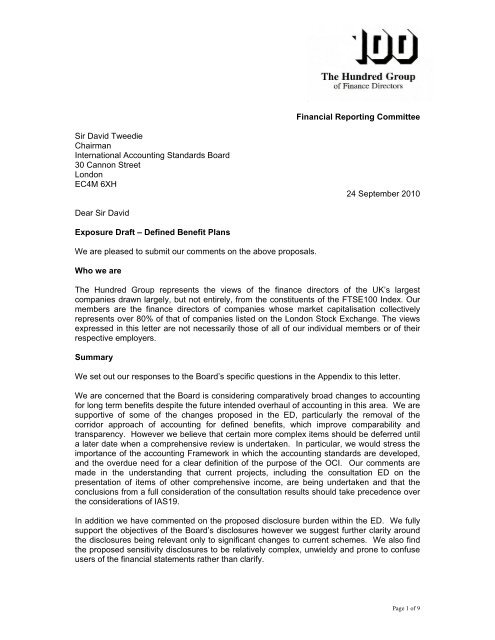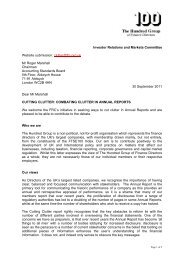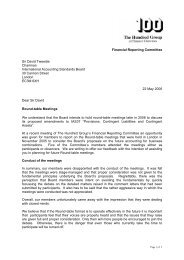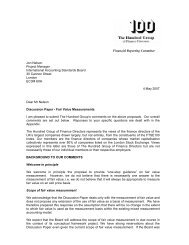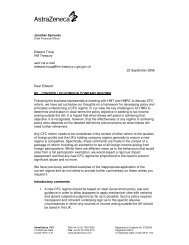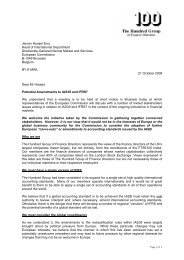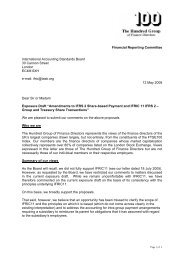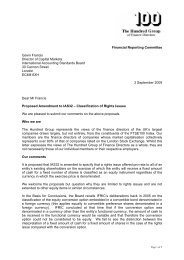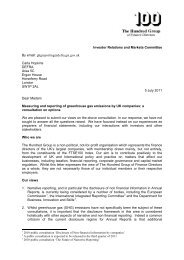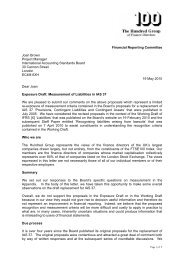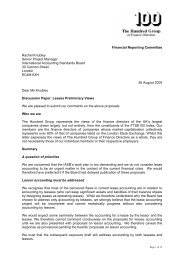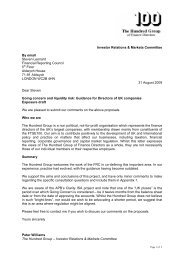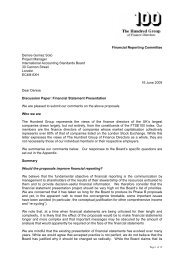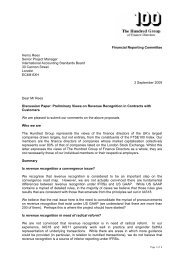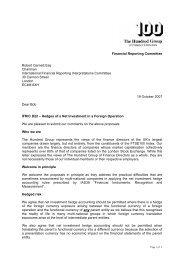Financial Reporting Committee Sir David Tweedie Chairman ...
Financial Reporting Committee Sir David Tweedie Chairman ...
Financial Reporting Committee Sir David Tweedie Chairman ...
You also want an ePaper? Increase the reach of your titles
YUMPU automatically turns print PDFs into web optimized ePapers that Google loves.
<strong>Sir</strong> <strong>David</strong> <strong>Tweedie</strong><br />
<strong>Chairman</strong><br />
International Accounting Standards Board<br />
30 Cannon Street<br />
London<br />
EC4M 6XH<br />
Dear <strong>Sir</strong> <strong>David</strong><br />
Exposure Draft – Defined Benefit Plans<br />
We are pleased to submit our comments on the above proposals.<br />
Who we are<br />
<strong>Financial</strong> <strong>Reporting</strong> <strong>Committee</strong><br />
24 September 2010<br />
The Hundred Group represents the views of the finance directors of the UK’s largest<br />
companies drawn largely, but not entirely, from the constituents of the FTSE100 Index. Our<br />
members are the finance directors of companies whose market capitalisation collectively<br />
represents over 80% of that of companies listed on the London Stock Exchange. The views<br />
expressed in this letter are not necessarily those of all of our individual members or of their<br />
respective employers.<br />
Summary<br />
We set out our responses to the Board’s specific questions in the Appendix to this letter.<br />
We are concerned that the Board is considering comparatively broad changes to accounting<br />
for long term benefits despite the future intended overhaul of accounting in this area. We are<br />
supportive of some of the changes proposed in the ED, particularly the removal of the<br />
corridor approach of accounting for defined benefits, which improve comparability and<br />
transparency. However we believe that certain more complex items should be deferred until<br />
a later date when a comprehensive review is undertaken. In particular, we would stress the<br />
importance of the accounting Framework in which the accounting standards are developed,<br />
and the overdue need for a clear definition of the purpose of the OCI. Our comments are<br />
made in the understanding that current projects, including the consultation ED on the<br />
presentation of items of other comprehensive income, are being undertaken and that the<br />
conclusions from a full consideration of the consultation results should take precedence over<br />
the considerations of IAS19.<br />
In addition we have commented on the proposed disclosure burden within the ED. We fully<br />
support the objectives of the Board’s disclosures however we suggest further clarity around<br />
the disclosures being relevant only to significant changes to current schemes. We also find<br />
the proposed sensitivity disclosures to be relatively complex, unwieldy and prone to confuse<br />
users of the financial statements rather than clarify.<br />
Page 1 of 9
Please feel free to contact me if you wish to discuss our comments on the proposals.<br />
Yours sincerely<br />
Chris Lucas<br />
<strong>Chairman</strong><br />
The Hundred Group - <strong>Financial</strong> <strong>Reporting</strong> <strong>Committee</strong><br />
Page 2 of 9
Recognition<br />
APPENDIX<br />
Question 1: The exposure draft proposes that entities should recognise all changes in<br />
the present value of the defined benefit obligation and in the fair value of plan assets<br />
when they occur. (Paragraphs 54, 61 and BC9–BC12) Do you agree? Why or why not?<br />
We agree that all changes in the present value of the defined benefit obligation in the fair<br />
value of plan assets should be recognised when they occur – i.e. the removal of the ‘corridor’<br />
deferral method for actuarial gains and losses.<br />
The current option to defer recognition can fail to reflect the position of an entity’s liabilities<br />
and is inconsistent with the definition and recognition criteria of assets and liabilities in the<br />
Framework. In addition, the changes proposed will improve comparability between entities<br />
by eliminating an accounting option, thereby improving transparency.<br />
We note that the proposals set out in the ED are intended as an interim step before a<br />
complete overhaul of accounting for employee benefits and against a background of many<br />
other changes in financial reporting. In light of this position we recommend that the Board<br />
consider minimal changes to IAS19 at this time and that some of the more complex<br />
principles should be deferred until the full review of accounting for employee benefits is<br />
undertaken. In particular we do not support the proposal to align the treatment of other longterm<br />
benefits with that of post-employment benefits at this stage of the overall project.<br />
Question 2: Should entities recognise unvested past service cost when the related<br />
plan amendment occurs? (Paragraphs 54, 61 and BC13) Why or why not?<br />
We agree with the recognition of unvested past service cost in the period in which the related<br />
plan amendment occurs as this eliminates an inconsistency with the general measurement<br />
requirements applicable to other elements of defined benefit plans in IAS19.<br />
Disaggregation<br />
Question 3: Should entities disaggregate defined benefit cost into three components:<br />
service cost, finance cost and remeasurements? (Paragraphs 119A and BC14–BC18)<br />
Why or why not?<br />
We agree with the proposed disaggregation of changes in the net defined benefit liability<br />
(asset) in respect of post-employment benefits. We believe that the separate presentation of<br />
the different components of changes in pension obligations has value for users in enhancing<br />
comparability and providing clear differentiation between funded and unfunded schemes. In<br />
addition we note that the differing nature and predictability of the different components<br />
provides further strength to the argument for separation.<br />
However, as outlined in our answer to question 1, we do not support the proposals to include<br />
other long term benefits alongside post-employment benefits at this stage of the project.<br />
Defining the service cost component<br />
Question 4: Should the service cost component exclude changes in the defined<br />
benefit obligation resulting from changes in demographic assumptions? (Paragraphs<br />
7 and BC19 –BC23) Why or why not?<br />
We agree that the service cost component should exclude changes in the defined benefit<br />
obligation resulting from changes in demographic assumptions. In our opinion demographic<br />
Page 3 of 9
assumptions form part of the actuarial assumptions and they should be treated in the same<br />
manner as other actuarial assumptions.<br />
Defining the finance cost component<br />
Question 5: The exposure draft proposes that the finance cost component should<br />
comprise net interest on the net defined benefit liability (asset) determined by<br />
applying the discount rate specified in paragraph 78 to the net defined benefit liability<br />
(asset). As a consequence, it eliminates from IAS 19 the requirement to present an<br />
expected return on plan assets in profit or loss.<br />
Should net interest on the net defined benefit liability (asset) be determined by<br />
applying the discount rate specified in paragraph 78 to the net defined benefit liability<br />
asset)? Why or why not? If not, how would you define the finance cost component and<br />
why? (Paragraphs 7, 119B, 119C and BC23–BC32)<br />
We do not support the definition and presentation of net interest on the net defined benefit<br />
liability (asset).<br />
We believe that the limitations of this approach outlined in BC32 outweigh the practical<br />
expedient of applying the net interest approach, namely that plan assets are made up of<br />
many different types of investments and that the return on high quality corporate bonds<br />
would be arbitrary. The fact that this would not be a faithful representation of the return that<br />
investors require or expect from each type of assets also undermines the proposed<br />
approach. We believe also that this is more reflective of the two distinct elements of the net<br />
pension liability shown in the financial statements and their differing risks, rewards and<br />
management strategies.<br />
We believe that the current requirements of IAS19 should be retained for the expected return<br />
on plan assets, reflecting the income on the scheme assets (the investment strategy) and<br />
utilising the existing discount rate on plan liabilities. The current requirements are now well<br />
understood by users of the financial statements and further changes should be, in our<br />
opinion, deferred until the comprehensive review of long term benefit accounting.<br />
Presentation<br />
Question 6: Should entities present:<br />
(a) service cost in profit or loss?<br />
(b) net interest on the net defined benefit liability (asset) as part of finance costs in<br />
profit or loss?<br />
(c) remeasurements in other comprehensive income?<br />
(Paragraphs 119A and BC35–BC45) Why or why not?<br />
We support the proposed presentation requirements. We support the increase in<br />
comparability and clarity that these requirements will bring to financial reporting.<br />
However, we make these comments understanding the current consultation for the ED on<br />
the presentation of items of other comprehensive income. We are of the opinion that any<br />
conclusions reached as part of the review of IAS19 should not determine the purpose of<br />
Other Comprehensive Income and accordingly should be tentative proposals which can be<br />
adapted in light of conclusions reached after further clarification over the purpose of Other<br />
Comprehensive Income. Only with a conceptual basis to Other Comprehensive Income<br />
should firm conclusions be drawn as to individual disclosure requirements.<br />
Settlements and curtailments<br />
Page 4 of 9
Question 7: (a) Do you agree that gains and losses on routine and non-routine<br />
settlement are actuarial gains and losses and should therefore be included in the<br />
remeasurement component? (Paragraphs 119D and BC47) Why or why not?<br />
(b) Do you agree that curtailments should be treated in the same way as plan<br />
amendments, with gains and losses presented in profit or loss? (Paragraphs 98A,<br />
119A(a) and BC48)<br />
(c) Should entities disclose (i) a narrative description of any plan amendments,<br />
curtailments and non-routine settlements, and (ii) their effect on the statement of<br />
comprehensive income? (Paragraphs 125C(c), 125E, BC49 and BC78) Why or why<br />
not?<br />
(a) We agree that gains and losses on routine settlements (experience adjustments)<br />
should be treated like other actuarial gains and losses and recognised in other<br />
comprehensive income to the extent we support the allocation with regard to the<br />
current ED exploring the purpose of Other Comprehensive Income.<br />
However, we believe that non-routine settlements should be treated as plan<br />
amendments and should be presented in profit or loss. We note that non-routine<br />
settlement is often combined with a curtailment or plan amendment and presentation<br />
of all elements in profit or loss would provide more meaningful reporting than a more<br />
judgemental separation of the different elements. Further definition or guidance may<br />
be required to differentiate routine and non-routine settlements.<br />
(b) We agree that curtailments should be treated in the same way as plan amendments,<br />
particularly as in practice the distinction is not always clearly drawn. We would<br />
expect gains and losses on curtailments to be calculated in the same manner as<br />
gains and losses on settlements.<br />
(c) We agree that entities should disclose a narrative description of any plan<br />
amendments, curtailments and non-routine settlements to the extent that these are<br />
material to the long term employee benefits disclosure and therefore necessary for<br />
the user’s understanding of the financial position and results for the period.<br />
Disclosures<br />
Question 8: The exposure draft states that the objectives of disclosing information<br />
about an entity’s defined benefit plans are:<br />
(a) to explain the characteristics of the entity’s defined benefit plans;<br />
(b) to identify and explain the amounts in the entity’s financial statements arising from<br />
its defined benefit plans; and<br />
(c) to describe how defined benefit plans affect the amount, timing and variability of<br />
the entity’s future cash flows. (Paragraphs 125A and BC52–BC59)<br />
Are these objectives appropriate? Why or why not? If not, how would you amend the<br />
objectives and why?<br />
We agree with the objectives for disclosure and support the Board’s objectives to establish<br />
disclosures that ‘provide sufficient disclosure around defined benefit plans when those plans<br />
are material to the operations of the entity’ and ‘provide users of the financial statements with<br />
relevant information that is not obscured by excessive detail’. Our comments on the detailed<br />
disclosures are set out below.<br />
Question 9: To achieve the disclosure objectives, the exposure draft proposes new<br />
disclosure requirements, including:<br />
(a) information about risk, including sensitivity analyses (paragraphs 125C(b), 125I,<br />
BC60(a), BC62(a) and BC63–BC66);<br />
Page 5 of 9
(b) information about the process used to determine demographic actuarial<br />
assumptions (paragraphs 125G(b) and BC60(d) and (e));<br />
(c) the present value of the defined benefit obligation, modified to exclude the effect of<br />
projected salary growth (paragraphs 125H and BC60(f));<br />
(d) information about asset-liability matching strategies (paragraphs 125J and<br />
BC62(b)); and<br />
(e) information about factors that could cause contributions to differ from service cost<br />
(paragraphs 125K and BC62(c)).<br />
Are the proposed new disclosure requirements appropriate? Why or why not?<br />
If not, what disclosures do you propose to achieve the disclosure objectives?<br />
We would urge the board to reconsider such a mandatory and exhaustive list of disclosures<br />
in light of the objectives set out in paragraph BC53.<br />
In particular we consider the sensitivity analysis as proposed for each key actuarial<br />
assumption to be particularly onerous and unlikely to meet a cost/benefit test nor to reach the<br />
objectives of paragraph BC53(b). In particular the disclosures outlined in paragraph<br />
125I(a)(ii) would have limited information to users as it is derived from historic information.<br />
We believe that users of the financial statements understand that the assumptions utilised in<br />
calculations are precisely that – assumptions, and that these assumptions can and will<br />
change by necessity. Increasing the level of disclosures in this manner we believe will only<br />
serve to confuse rather than illuminate.<br />
We also believe that the proposed disclosure requirements of paragraph 125H are<br />
inappropriate and do not meet the disclosure objectives set out by the Board. We do not<br />
believe that this information will assist users of the accounts to understand the nature of the<br />
liability held by the entity.<br />
In addition, requirements as laid out in paragraphs 125J and 125K should only be required<br />
for significant events for defined benefit schemes to ensure a focused and informative set of<br />
disclosures.<br />
Multi-employer plans<br />
Question 10: The exposure draft proposes additional disclosures about participation<br />
in multi-employer plans. Should the Board add to, amend or delete these<br />
requirements? (Paragraphs 33A and BC67–BC69) Why or why not?<br />
We agree that entities participating in multi-employer plans face greater risks than other<br />
entities and agree with the proposed enhanced disclosure requirements. However, we are<br />
concerned that the information presented as proposed may lack comparability between<br />
entities. As a result it would be difficult to aggregate multi-employer plans thereby obscuring<br />
the true financial position of the plan.<br />
State plans and defined benefit plans that share risks between various entities under<br />
common control<br />
Question 11: The exposure draft updates, without further reconsideration, the<br />
disclosure requirements for entities that participate in state plans or defined benefit<br />
plans that share risks between various entities under common control to make them<br />
consistent with the disclosures in paragraphs 125A–125K. Should the Board add to,<br />
amend or delete these requirements? (Paragraphs 34B, 36, 38 and BC70) Why or why<br />
not?<br />
We agree with the Board’s proposals regarding state plans. State plans are accounted for as<br />
if they were multi-employer plans and therefore it is appropriate that the same disclosure<br />
Page 6 of 9
equirements apply, including an acknowledgement, where appropriate, that there may be<br />
information constraints in some areas.<br />
Other comments<br />
Question 12: Do you have any other comments about the proposed disclosure<br />
requirements? (Paragraphs 125A–125K and BC50–BC70)<br />
No further comments.<br />
Other issues<br />
Question 13: The exposure draft also proposes to amend IAS 19 as summarised<br />
below:<br />
(a) The requirements in IFRIC 14 IAS 19—The Limit on a Defined Benefit Asset,<br />
Minimum Funding Requirements and their Interaction, as amended in November 2009,<br />
are incorporated without substantive change. (Paragraphs 115A–115K and BC73)<br />
(b) ‘Minimum funding requirement’ is defined as any enforceable requirement for the<br />
entity to make contributions to fund a post-employment or other long-term defined<br />
benefit plan. (Paragraphs 7 and BC80)<br />
(c) Tax payable by the plan shall be included in the return on plan assets or in the<br />
measurement of the defined benefit obligation, depending on the nature of the tax.<br />
(Paragraphs 7, 73(b), BC82 and BC83)<br />
(d) The return on plan assets shall be reduced by administration costs only if those<br />
costs relate to managing plan assets. (Paragraphs 7, 73(b), BC82 and BC84–BC86)<br />
(e) Expected future salary increases shall be considered in determining whether a<br />
benefit formula expressed in terms of current salary allocates a materially higher level<br />
of benefits in later years. (Paragraphs 71A and BC87–BC90)<br />
(f) The mortality assumptions used to determine the defined benefit obligation are<br />
current estimates of the expected mortality rates of plan members, both during and<br />
after employment. (Paragraphs 73(a)(i) and BC91)<br />
(g) Risk-sharing and conditional indexation features shall be considered in<br />
determining the best estimate of the defined benefit obligation. (Paragraphs 64A, 85(c)<br />
and BC92–BC96)<br />
Do you agree with the proposed amendments? Why or why not? If not, what<br />
alternative(s) do you propose and why?<br />
We are generally supportive of the proposed amendments and have the following remarks:<br />
c) We believe that it should be clarified how taxes payable should be estimated, and whether<br />
‘taxes payable’ includes employment taxes and other similar social security payments<br />
relating to post-employment benefits.<br />
d) We have some concern that the practical issues in dealing with costs may not been fully<br />
addressed. In practice some costs will go through the fund and others will be paid direct by<br />
the company, while the split between administrative and investment costs is likely to be fairly<br />
arbitrary in many cases.<br />
Multi-employer plans<br />
Question 14: IAS 19 requires entities to account for a defined benefit multi-employer<br />
plan as a defined contribution plan if it exposes the participating entities to actuarial<br />
risks associated with the current and former employees of other entities, with the<br />
result that there is no consistent and reliable basis for allocating the obligation, plan<br />
assets and cost to individual entities participating in the plan. In the Board’s view, this<br />
Page 7 of 9
would apply to many plans that meet the definition of a defined benefit multiemployer<br />
plan. (Paragraphs 32(a) and BC75(b))<br />
Please describe any situations in which a defined benefit multi-employer plan has a<br />
consistent and reliable basis for allocating the obligation, plan assets and cost to the<br />
individual entities participating in the plan. Should participants in such multi-employer<br />
plans apply defined benefit accounting? Why or why not?<br />
We support the proposals by the board.<br />
Transition<br />
Question 15: Should entities apply the proposed amendments retrospectively?<br />
(Paragraphs 162 and BC97–BC101) Why or why not?<br />
We generally agree that the proposed amendments should be introduced retrospectively.<br />
However, we believe that practical difficulties may be incurred with retrospective adoption of<br />
certain disclosure requirements. Therefore we recommend that the Board considers<br />
introducing provisions over the applicability of some disclosures (for example sensitivity<br />
disclosures) on transition.<br />
Benefits and costs<br />
Question 16: In the Board’s assessment:<br />
(a) the main benefits of the proposals are:<br />
(i) reporting changes in the carrying amount of defined benefit obligations and<br />
changes in the fair value of plan assets in a more understandable way.<br />
(ii) eliminating some presentation options currently allowed by IAS 19, thus improving<br />
comparability.<br />
(iii) clarifying requirements that have resulted in diverse practices.<br />
(iv) improving information about the risks arising from an entity’s involvement in<br />
defined benefit plans.<br />
(b) the costs of the proposal should be minimal, because entities are already required<br />
to obtain much of the information required to apply the proposed amendments when<br />
they apply the existing version of IAS 19.<br />
Do you agree with the Board’s assessment? (Paragraphs BC103–BC107) Why or<br />
why not?<br />
We do not believe that the benefit of the full ED outweighs the costs, particularly if the<br />
adoption of these proposals were to be followed in the relatively short term by further<br />
changes, requiring further expense.<br />
The proposal to remove the corridor method of accounting is comparatively straight forward<br />
to apply, as is the separation of component charges in the profit or loss and statement of<br />
other comprehensive income and expense.<br />
However, we believe that the elimination of the expected rate of return on plan assets and<br />
the changes in definitions of employee benefits in the ED do not have clear benefits. We<br />
believe that these will be confusing to users of the accounts and reduce rather than improve<br />
understanding.<br />
We also draw the Board’s consideration to the costs of preparing the proposed disclosure<br />
requirements which should not be underestimated.<br />
Other comments<br />
Question 17: Do you have any other comments on the proposals?<br />
Page 8 of 9
We believe that the Board has suggested some areas for clarification which would improve<br />
comparability in financial reporting, in particular the removal of the corridor method of<br />
accounting for defined benefits.<br />
However, we urge the Board to defer significant changes to accounting for defined benefits<br />
until the comprehensive review later in the review cycle. In addition we are concerned with<br />
the increasing burden of disclosure which in some cases we believe will impede the users’<br />
understanding, undermining the objectives laid out by the Board.<br />
Page 9 of 9


